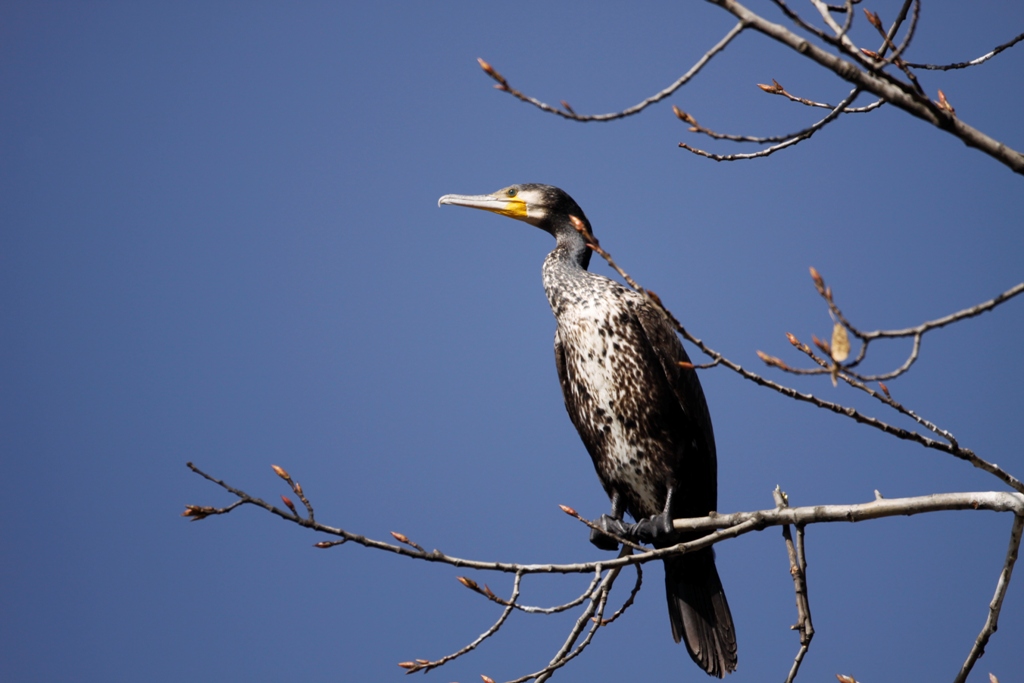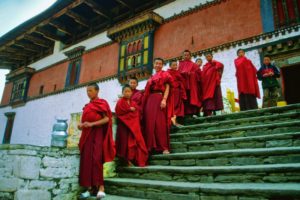
Bhutan is a paradise for bird lovers and ornithology. Over 670 species of birds have been recorded and many more are yet to be discovered. Around 50 species of the known birds are winter migrants. These include ducks, waders, birds of prey, thrushes, finches and buntings.
The partial migrants to Bhutan include cuckoos, swifts, bee-eaters, warblers and flycatchers. The country harbors more than 16 species of vulnerable birds. They are the Pallas’s Fish Eagle, White bellied Heron, Satyr Tragopan, Gray-bellied Tragopan, Ward’s Trogon, Blyth’s King Fisher, Yellow-rumped Honey Guide, Rufous Throated Wren Babbler, Chestnut-breasted Partridge, Blyth’s Trogon, Wood Snipe, Dark-rumped Swift, Rufous-necked Hornbill, Graycrowned Prinia and the Beautiful Nuthatch all of which breed in Bhutan.
Bhutan is home to many species of birds that are in danger of extinction, including the Imperial Heron, which is one of the fifty rarest birds in the world and the rare Black-Necked Crane, which breeds in Tibet and then migrates over the Himalayas to Bhutan during the winter months. The Cranes can be spotted in Phobjikha Valley in Western Bhutan, Bumthang in Central Bhutan and 43 in Bomdeling in Eastern Bhutan. They migrate to these winter roosting sites in the months of September and October and fly back to Tibet between February and March.
Day 1: PARO – THIMPHU
Upon arrival at Paro International airport, you will be met by a specialist ornothology guide. Then drive for about one hour through the mountains of Western Bhutan to Thimphu, Bhutan’s delightful capital city. Along the way, you may see Red-billed Choughs which are quite common in this valley – and as you head east stop to look for Ibisbill and Brown Dipper. With luck you might also see a Rufous-fronted Tit.
Dinner and overnight at your hotel in Thimphu.
Day 2: THIMPHU – PUNAKHA
After breakfast commence a mixed camping and hotel expedition by taking the West-East Road to the western slopes of the Dochula, the first of a series of high altitude road passes that you will explore. As you enter the mixed forests of hemlock, fir, oak, blossoming magnolias and rhododendrons, we will hope to see a wealth of bird life. Quarrelsome Nutcrackers are common and you may have the chance to see a skulking Hill Partridge, a Satyr Tragopan, a Golden Bush Robin, an immaculate Cutia, a Brown Parrotbill or even the gorgeous Fire-tailed Myzornis. Most of the birding on this tour will be from the roads which are well paved but generally quite free of traffic. Today however, we will go off-road and on to a trail that allows you to explore the forest more thoroughly. Sometimes the Ward’s Trogon, one of Bhutan’s premier avian prizes, has been spotted.
Dinner and overnight camping in Punakha.
Day 3: PUNAKHA
Today explore the braided channels of the Mo Chhu river and the bird-rich sub-tropical forests it contains. Our route will take us past the spectacular Punakha Dzong (a fortress and monastery combined). You should see an impressive array of species here, and you may even see a White-bellied Heron, one of Bhutan’s rarest birds. Brightly coloured minivets, noisy Striated Laughing thrushes and Ibisbills will likely also be seen. A whole host of forest species such as Bay Woodpecker, Red-headed Trogon, and Wedge-tailed Pigeon, wait to be discovered. The Fire-capped Tit breeds here, as does the White-gorgeted Flycatcher and the rare Yellow-vented Warbler. We will search for a variety of skulkers including the Lesser Shortwing, Spotted and Pygmy Wren-Babblers and two of the three species of tesia.
Dinner and overnight camping in Punakha.
Day 4: PUNAKHA – GANGTEY
Continuing east past Wangdi Dzong (another monastery and fortress combined), we will make a series of brief stops to scan the braided river channel. We will also check the forest edges and explore some small patches of cultivation. Towards the end of the day, we will enter a productive forest and will stop there to look for species such as the Blood Pheasant, Satyr Tragopan and the majestic Himalayan Monal. Spotted Laughing Thrush, Yellowish- bellied Bush-Warbler, Rusty-flanked Tree Creeper, White-browed Bush Robin and White-winged Grosbeak also occur here.
Dinner and overnight at your hotel in Gangtey.
Day 5: GANGTEY – TRONGSA
Here you will have an opportunity to observe one of the largest colonies in the world of the endangered Black Necked Crane before leaving Gangtey to follow the winding road over the Pelela pass into Central Bhutan. A stand of ringal bamboo extends for about three miles below the pass and here we will search here for birds such as the Great and Brown Parrotbills, and the Golden-breasted Fulvetta, surely one of the world’s most attractive.
Dinner and overnight at your hotel in Trongsa.
Day 6-7: TRONGSA – ZHEMGANG
From Trongsa head south to our next camp site near Zhemgang. Our main target at the start of this journey is the rare and little-known Yellow-rumped Honeyguide, but we should also see a number of other species, perhaps including Fire-capped Tit, Large Niltava, and Russet Bush Warbler. The entire length of this spectacularly forested valley is also a good area for The endangered Golden Langur monkey. The beautiful Nuthatch can sometimes be seen on this section of road, and we will spend some time searching for this magnificent bird. Our camp site will be right in the heart of some superb forest in one of the lowest altitudes that we will visit in Bhutan. Bird species which can be seen here include the Chestnut-breasted Partridge, Violet Cuckoo, Pin-tailed Green Pigeon, Rufous-necked Hornbill and Cutia. The Rufous-faced Warbler is also quite common here. You also stand a further chance of encountering the rare White-bellied Heron. We spend two nights camping here in spacious tents and sleeping on comfortable camp beds which have been set up by your Bhutanese
Dinner and overnight camping in Zhemgang.
Day 8: ZHEMGANG – BUMTHANG
Retracing our route we head back north today through Trongsa before climbing over a bamboo-thronged pass into the first of the four Bumthang Valleys. The scenery suddenly changes to broad grassy valleys and rolling hillsides covered in spruce and fir and the avifauna changes equally abruptly. Nutcrackers can be common, though you will have to spend a little more time searching for the region’s real specialities – the Slender-billed Scimitar Babbler, Fulvous, Brown and Great Parrotbills, White-browed and Rufous-breasted Bush Robins and Dark-rumped Rosefinch.
Dinner and overnight at your hotel in Bumthang.
Day 9: BUMTANG – SENGOR
An early start today before continuing a circuit east and searching for pheasants which could include Monal, Satyr Tragopan and the Blood Pheasant. We will climb, and eventually cross, the Thrumsingla, which at 3800m is Bhutan’s highest road pass. The road then plunges dramatically down into rich semi-tropical rainforest and you will be on the Lingmethang road, perhaps Asia’s premier birding road. Many of Bhutan’s most sought-after birds can be found here including the Chestnut-breasted Partridge, Ward’s Trogon, the majestic Rufous- necked Hornbill, Blue-naped Pitta, Blue-fronted Robin, and the Sikkim Wedge-billed, Long-billed and Bar-winged Wren-Babblers.
Dinner and overnight camping in Sengor.
Day 10-11: SENGOR – LINGIMITHANG
Spend these two days exploring the fabulous, lush primary forests near Lingmethang in search of the area’s specialities. You should see many new birds, and while not all of these are rare, many of them, such as the Slender-billed and Coral-billed Scimitar-Babblers, Scaly and Blue-winged Laughing Thrushes, Greater Rufous-headed Parrotbill, Broad-billed Warbler, White-naped Yuhina, and Rufous-throated Wren-Babbler are poorly known and unfamiliar to most birders.
Dinner and overnight camping in Lingmithang.
Day 12: LINGIMITHANG – TRASHIGANG
Leaving the campsite you continue your journey east towards Trashigang, a small town in North eastern Bhutan. You will spend the night camping at a site where Black-tailed Crake are regularly seen.
Dinner and overnight camping in Trashigang.
Day 13: TRASHIGANG – NARPHUNG
Today head south en route to south eastern Bhutan. Your journey takes us through a series of villages and you will stop to view an ornate Buddhist temple, before continuing over several forest-covered passes and down spectacular river valleys. Easternmost Bhutan is poorly known ornithologically and we will make several exploratory birding stops amid superb forests near Narphung before we reach our camp. Birds such as the Grey-sided Laughing Thrush and Ward’s Trogon have previously been seen here.
Dinner and overnight camping in Narphung.
Day 14: NARPHUNG – DEOTHANG
The campsite near Narphung is in the heart of prime mid-altitude forest and provides us with opportunities to study the birds of this rich biotope. You will spend the entire day birding in the forests between Morong and Deothang, having breakfast and lunch in the field. We expect to arrive at Samdrup Jongkhar, the base for the following two nights by the early evening. Today’s target species will include Mountain Imperial Pigeons, Dark-rumped Swift, Long-tailed Broadbill, Rufous-necked Laughing Thrush and we stand another chance of encountering the enigmatic Beautiful Nuthatch.
Dinner and overnight camping in Deothang.
Day 15: DEOTHANG – SAMDRUP JONGKHAR
Today explore the forested hill slopes around Samdrup Jongkhar, a bustling border town lying at the junction of the Himalayas and the Brahmaputra flood plain. Here you may find species such as Grey Peacock Pheasant, Jerdon’s Baza, Pied Falconet, Dark-rumped Swift, Wreathed Hornbill, Whistling Hawk-Cuckoo, Pin-tailed Green-Pigeon, Violet Cuckoo, and Sultan Tit.
Dinner and overnight at your hotel in Samdrup Jongkhar.
Day 16: SAMDRUP JONGKHAR – GUWAHATI
After breakfast it is a three hour drive through to Guwahati International Airport in India.


